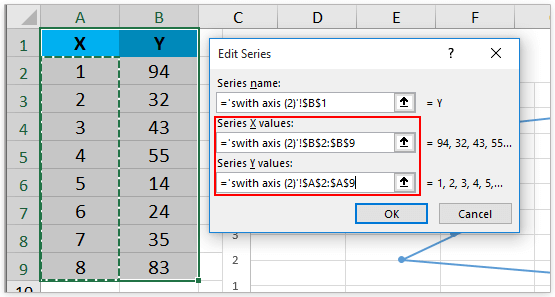

- Select data for chart excel mac how to#
- Select data for chart excel mac for mac#
- Select data for chart excel mac pro#
- Select data for chart excel mac series#
- Select data for chart excel mac mac#
A bit more complicated is to use Excel’s Names to define the series data for your chart. The easiest way is to use Tables as the chart source data. There are a couple ways to create charts that will grow with your data. If the data in the cells changes, so does the chart, but if the data extends to more cells (or shrinks to fewer cells), the chart doesn’t seem to notice. But once you’ve created a chart, it keeps plotting data from the same cells. It’s pretty easy to set up data and create a chart in Excel.
Select data for chart excel mac mac#
This exercise was done completely in Mac Excel 2016, and other than not knowing a few of the shortcuts I use everyday, it was not very different from working in Windows Excel 2016.
Select data for chart excel mac for mac#
The protocols are the same for Mac Excel and Windows Excel, and perhaps it’s time for a quick review.
Select data for chart excel mac pro#
So I dusted off my MacBook Pro and tried it out.īottom line: There are several ways to make dynamic charts in Excel, and there seems to be no difference other than cosmetic in how they work between different versions of Excel, and between operating system. Good question, and I wondered if he’d encountered some unexpected problem, perhaps a bug, in Mac Excel. Please do not hesitate to contact us, if you are having trouble viewing or accessing this article.A reader emailed to ask whether you could make a dynamic chart using OFFSET-function-based Names in Excel 2016 for Mac. You may also want to add a text box to the chart (Insert menu, Text box) to show the current value.Ĭongratulations! Your football field chart is now ready to be used: If necessary, you can change the line formatting (for example, to have a dotted line or to change its color) by right-clicking the line and selecting Format Shape. Draw a vertical line on the chart, positioning it where relevant. Add a vertical line for the current market priceĬlick on the Insert menu, select Shapes and then select the Line. At this stage, your chart should look like this:Ĩ. You may also want to expand the chart to the right, to stretch the valuation ranges. Change the parameters to adjust the value range and to make any other formatting changes as required (for example, to change the font or the number of decimals). Right-click on the X Axis labels and select “Format Axis”. Remove the vertical gridlines by clicking on them and hitting the delete key. At this stage your chart should look like this: Right-click on the floating bar (the red bars in the chart above) and select “Add Data Labels”. Right-click again on the same series and select “Format Data Labels”, then choose “Inside End” for label position. Right-click on the series colored white and select “Add Data Labels”. This has hidden the series, so your chart should show floating bars for each valuation methodology. Select “Fill” as “Solid fill” and choose the color as “White” (to match the chart background), as shown below: Right-click on one of the long bars (the blue bars in the example above) to select the series and choose “Format Data Series”. Select “Series1” (in the pane on the left) and move it down by clicking on the down arrow, as shown below: Right-click on one bar to select the series and choose “Select data”. The two series should now overlap, so the chart shows only one bar for each valuation method, as in the example below: Under “Series options”, change the “Series overlap” to 100%, as shown below: Right-click on one of the bars, which will select all of the bars of the same color (the “data series”) and select “Format Data Series”, which will open the related menu. You may also want to include an appropriate title for your chart, or delete it (by clicking on it and hitting the delete key) as necessary. The legend must be deleted: click on it and hit the delete key. This procedure should have created a bar chart.Ī legend will appear, either to the side of the chart or under the chart, as shown below: Select the data in the table, excluding the first row (where the headers are), then select the Insert menu, select the bar charts group and click on the Clustered bar. Ensure your table does not include any blank rows (if it does, delete them). You can copy and paste this table into Excel to use as an example. The example below shows enterprise values, but it can be used to display share prices or any other valuation measurement. It is applicable to any version of Excel from 2007 to 2016.īelow are the valuation ranges that we need to build the football field for and the associated valuation methodologies.Īrrange the valuation data as a table in Excel.
Select data for chart excel mac how to#
This article shows how to build a football field chart in Excel. “Football field” charts are commonly used to compare the results of different valuation methodologies when applied to a given asset or corporation.


 0 kommentar(er)
0 kommentar(er)
